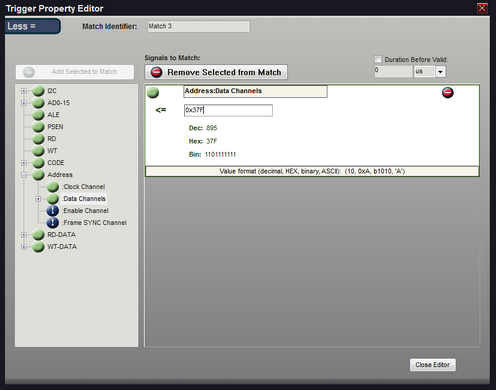The Less Than or Equal Match Editor:

ADD a Signal - Highlight a defined signal from the left portion of the window and click the "+" button to add it as the Less Than or Equal Match. You can also just "Double-Click" the defined signal to automatically add it. NOTE: High Level signal definitions (such as State, I2C, or etc) cannot be added directly as a complete signal. However, the individual portions of the signal (such as the DATA portion of a State Signal) can be added in the same manner. To see the sub-portions of a signal, click the "expand" button in the left column next to the signal's name, then add the sub portion in the same manner as any other signal.
For instance, if you have defined a Synchronous Serial signal (i.e. SPI) and you want to add the :Enable portion of the signal to the Greater Than match, then expand it and double-click on :Enable. It would then appear on the right portion of the editor.
The Less Than or Equal Match type only accepts one signal at a time. If you attempt to add a second signal, a dialog will appear asking if you want to replace the existing signal with the current one.
Note: If a signal is valid for the trigger configuration, a green icon will be displayed next to it. Any other icon, such as the blue circle above on the Frame Sync channel of the Address signal, indicates a signal state that is invalid for triggering. This particular icon indicates that the signal is 'Disabled'. Selecting Ignore in the signal definition editor for a particular sub-signal will disable the sub-signal throughout the application.
Delete a Signal - Highlight a signal in the right portion of the window (or mouse-over its bit selections) and click the "-" button to delete it from the Less Than or Equal Match.
Match Value Format - The value for the Less Than or Equal Match type can be entered in Decimal, HEX, Binary or ASCII format. The value will be limited to the maximum value allowed for the selected signal, which will depend on the number of bit positions assigned to the signal. The formats for entering each value type is described below.
Decimal: Enter any valid decimal value. An Invalid value will be cleared to 0 or assumed to be HEX.
HEX: Start the value with an "x" or a "0x". If too many digits are entered, the most significant nibble (leftmost) will be discarded. Any non-HEX digit will be ignored.
Binary: Enter "b" followed by "1's" and "0's". If too many digits are typed, the MSb (leftmost bit) will be discarded. Any numerical value larger than a "1" or non-numerical character will be considered a "1".
ASCII: Start the value with a single or double quote.
Duration - Enter the match duration by selecting the units then typing the value. The Maximum Duration period for Models DV3200, DV3209, DV3400, DV3409 and DV3500 is 5 ms; 10ms for Models DV3100 and DV3109. The Trigger condition will not be considered as "True" until the entered value for the selected signal has been valid for the indicated duration period.
Identifier - Change the identifier to something meaningful for the match condition if you do not want the default "Match #" to be displayed in the formula and the graphical configuration area of the trigger screen.